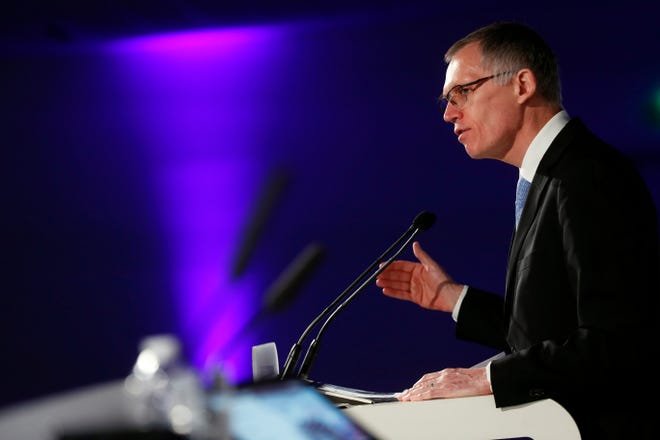Stellantis NV CEO Carlos Tavares says Ford Motor Co.’s restructuring to separate the company’s legacy business from its electric-vehicle operations is a way to impress investors — not consumers who should be the priority.
Ford Motor Co. this week said it’s creating two “distinct, but strategically interdependent” businesses: Ford Blue, home of the legacy business whose profits and industrial know-how will underpin the entire enterprise, and Ford Model e, which will field software, electrical and automotive talent to lead innovation and growth initiatives Ford executives see as key to competing in the automotive industry’s electric and digital transformation.

But such a strategy poses an ethical conundrum, Tavares said on Friday during a virtual roundtable with U.S. reporters, as internal combustion engine vehicles right now are funding investments to make EVs.
“If you make this kind of breakdown from an ethical HR management,” he said, “you have to explain to people who are working in the old world what is going to be their future. Their work is funding electrification, and you are clearly breaking down on two paths: one path that’s going to grow, hopefully profitably, and another path that is going to decrease and eventually disappear one day.
“So, from that perspective, I think that the management of this kind of breakdown is creating an HR challenge. I trust my teammates at Ford will be able to fix it. But I think it’s the question that we should be raising.”
Tavares says he understands the appeal of the decision to offer investors transparency into the journey toward EVs and get valuations closer to pure EV players like Tesla Inc. Ford Motor Co.’s shares jumped following the news on Wednesday of the reorganizing and closed Friday at $16.85., down 4.26% for the day.
“Overall, it’s a nice play, but I think it’s not the important play for the consumers,” Tavares said, adding that is Stellantis’ priority.
But Ford CEO Jim Farley on Wednesday said the changes are about the products and experiences the Dearborn automaker will offer customers — and the legacy business is holding the Blue Oval back from bringing them to market.
“This change is not about financial management of the company,” Farley said. “This is about focus, capabilities, better products, better experiences. It’s how we’re going to win as a company.”
What is important for consumers, Tavares said, is safe, clean and affordable mobility — a goal challenged today amid a global semiconductor shortage, inflation in raw materials like steel that he says need more competition, and a war in Ukraine that is increasing fuel prices, further distressing supply chains and causing some automakers like Volkswagen AG and BMW to halt production.
Stellantis’ supply lines are more centered in northern Africa than eastern Europe, he said, so the automaker has seen limited disruptions so far following Russia’s invasion into Ukraine last week.
“I know that with a longer pipe, we can discover things a few days, if not a few weeks later, that’s why I’m going to be cautious here,” Tavares said. “But I’m keeping my eyes open. So far, it’s OK, but I see that my peers actually shut down their plants, which means that possibly their pipe was shorter than mine.”
Stellantis also anticipates halting business in Russia, including at its commercial van plant with Mitsubishi Motors Corp. in Kaluga outside Moscow, though when will be determined by the sanctions affecting the ability to get components, Tavares said. The automaker had begun exporting vehicles to elsewhere in Europe last month and had plans to add assembly of transmissions and the Fiat Scudo there before the end of the year. Its whole operations in the country could be in jeopardy, he said.
“We cannot invest more, and we shouldn’t invest more right now,” Tavares said. “What we have to do is to make sure that we support the people, the employees, whatever the business consequences, that’s exactly what we have already decided. … The business is not counting. The conditions under which we will come back or not come back, it’s not counting.”
What the automaker is counting elsewhere is the additional 40% to 50% costs EVs represent over their gas- and diesel-powered counterparts. Stellantis is taking measures to cut spending to absorb the increases and avoid pricing out consumers. One area of focus is the cost of delivering vehicles to consumers, which represents 30% of the cost of an automobile, Tavares said.
Automakers like Tesla that sell directly to customers have a cost structure advantage, because they don’t work with independent dealers, but also frequently have to challenge franchise laws. Tavares says Stellantis is looking at more of a direct sales model to decrease costs associated with dealers and make the buying process less of a hassle for customers.
“There is a different distribution model that is being discussed where we have retailers, and we hand over the car to the final customer in what we would call the direct sales approach,” Tavares said. “And we would have the retailers supporting the handover, supporting the paperwork, taking care of the maintenance.”
The automaker is focused on these efforts in Europe as it eliminates overlapping retail footprints from the merger between Fiat Chrysler Automobiles NV and French rival Groupe PSA that created Stellantis last year, but the changes could come to the United States, too, he said.
“We’ll make sure that it’s a win-win,” Tavares said. “We’ll see with our dealer partners in the U.S. how they want to address this and if they want to address it.”
bnoble@detroitnews.com
Twitter: @BreanaCNoble